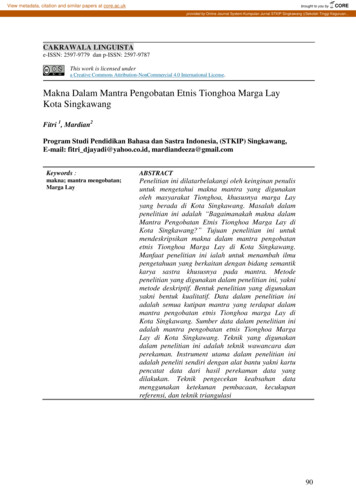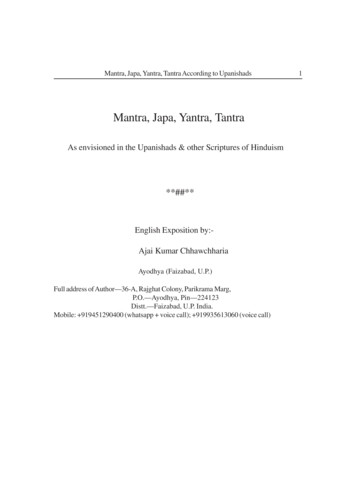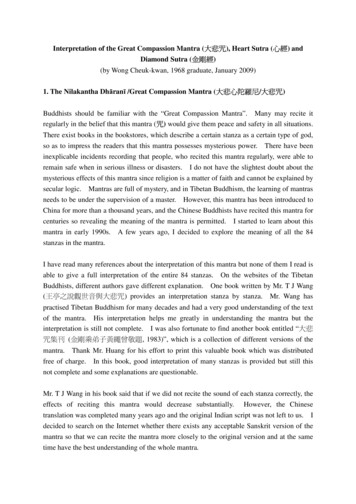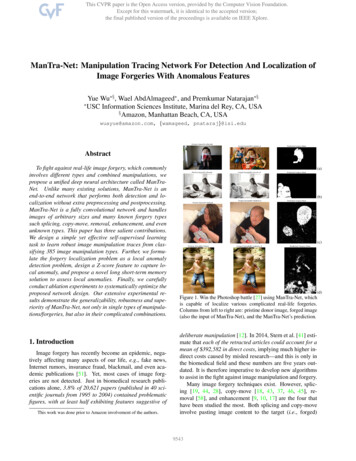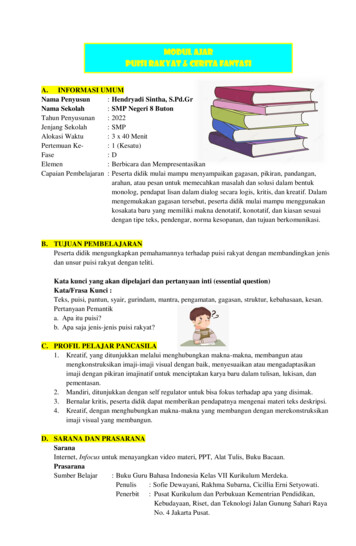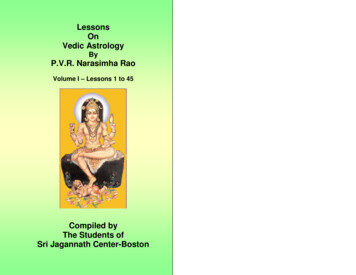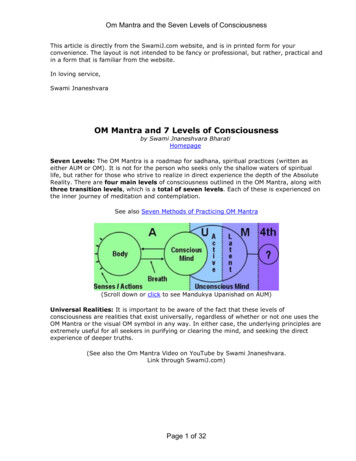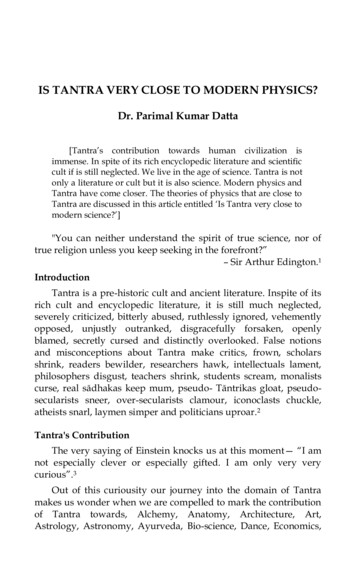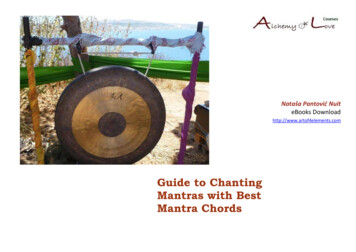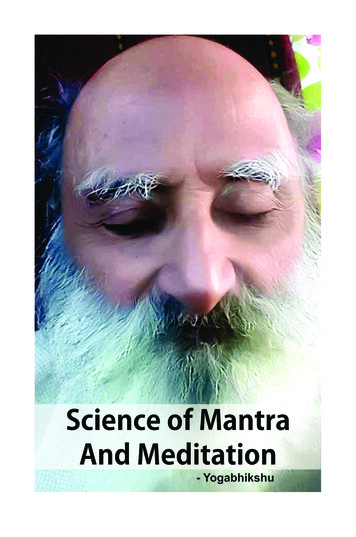
Transcription
Science of MantraAndMeditationYogabhikshuEnglish Translation – N C Vyasa
PREFACEIn Bhagvad Gita Lord Shri Krishna has sung glory of Japa-Yajna(i.e. a ritual of worship with Mantra chanting) with a verse“Yajnaanaam japa-yajnosmi” – meaning - in all rituals of worships Iam the Japa-Yajna. Giving the understanding of such Japa-Yajna inhis own original phraseology and style, reverend Shri Yogabhikshujisays –“The start of physical righteous acts happens with subtle righteousthoughts and subtle righteous thoughts get strength from the MantraJaap (i.e. Mantra recitation or Mantra chanting). There is hugeimportance and glory of Mantra-Jaap in Kalyug i.e. the age ofdownfall. Mantra-Jaap is considered as equivalent to Yajna i.e. ritualof worship. In Mantra-Jaap-Yajna there is no need of money, norneed of fire; there is no need of offerings into sacrificial fire, norneed of erudition. Recitation of Mantra can be done at any time andat any place; hence benefit of Mantra-Jaap must indeed be taken inKalyug by practicing it.”Aum-Parivaar frequently arranges programmes of Japa-Yajna inthe august presence of reverend Shri Yogabhikshuji. During theseprogrammes Shri Yogabhikshuji delivers lectures on the subjects ofscience of Mantra and Mantra-Jaap; thus the spiritual practitionersare benefitted with the true understanding about science of Mantra.Amen.At present, huge publicity and propagation is done about meditationi.e. Dhyana. If we take literal meaning of Dhyana which is ‘attention’then in our routine activities, we observe that every work is requiredand done with attention – Dhyana. But the said Dhyana is physical,outward and it is observed effortlessly. But the Dhyana which ispropagated is inward, subtle and it is practiced with efforts.Occasionally, reverend Shri Yogabhikshuji says –Modern destructive science is the result of extremely outward andmaterial Dhyana. The outward Dhyana increases external activitiesso much and to such an extent that apparently wise looking personhas reached to an insane stage. Whereas an inward Dhyana leads ahuman being to a stage where he/she becomes competent to achieveb
true happiness and peace and subsequently reaches to a stage of selfrealization and emancipation.There is a verse in Guru-Gita - Š² Ý} êHæ x éÚ ï} êü ¼ - meaning: Themeditation of an idol of Guru (spiritual master) is the root of allmeditations. This is extremely confidential secret. If a practitioner ofmeditation meditates on the idol of his/her spiritual master then he/she can easily observes meditation; because an idol of Guru isincarnate i.e. in bodily form hence is perceptible with the senses.When one reaches to the stage of profound meditation then thepractitioner, his aim for meditation and meditation itself merged intoone; at that time the Drashta (self or onlooker) obtains a state ofsteadiness (concentration) in Himself. That is the true attainment.“Science of Mantra and Meditation” – I hope that this bookletwould open new vistas for the practitioner of Mantra-Jaap andmeditation.- Naishadh VyasC
IndexNo.SubjectPage No.I – Science of Mantra1.2.3.4.5.6.7.8.9.10.11.12.13.14.15.Deep secret of Aum and Gayatri MantraKinds of MantraGuru-JaapSubtle science of Mantra chantingThe provider of Mantra must be full of vitalitySeer of MantraHow breathing can be made Mantra?Effect of Mantra-Jaap on human bodyAwakening of dormant energy by prolong intonationof AumThe most profound secret of Gayatri MantraA true Gayatri MantraGayatri Mantra is for purification of intellectGayatri Mantra is like a fireSperm control by Incantation-chantDigest the generated heat (power) through Mantra intobody itselfII – 9.30.Five afflictions and their formsFour stages of five afflictionsWhy meditation?How to make afflictions thinned-tenuous-subtle?Destroy the afflictions from their birth placeEffortless attention and meditation with efforts aredifferentExperience of universe – sitting at homeHow to meditate?Equality of Prana - vital force is backbone of goodhealthKalyug is the age of sciencePlavini PranayamaConcentration, Meditation and TranceA few remedies for attaining concentrationMeditation – with tactic of upward - downwardA fly on Ajna (third-eye) 4041424445
31.32.33.34.35.36.Can stomach be fed with meditation?Meditation (Dhyana) - Inwardly and outwardlyWe remain poor without inwardly meditationIn dream, luxuries can be enjoyed even without body!What does it prove?Rosary is helpful in meditationExtreme volatility of mind during meditation464849505354
Science of MantraDeep Secret of Aum-H and Gayatri MantraAum (H) - Pranav is the word that signifies Ishwar (SupremeBeing). ¼S² Ü: Ðí‡ :– Meaning: His (Supreme Being’s) name isAum (H). It is also called transcendental sound (Shabda Brahman).All fifty two letters of Sanskrit language are originated from Aum.The Sanskrit is the most valued language among all other languages.The main reason behind it is – Sanskrit language can give you theunderstanding of those subjects well which cannot be understood wellby other languages.When certain letters of Sanskrit language are arranged in a specificway and uttered, then particular vibrations are produced. And if thesearranged letters are uttered with decided rhythm for a certain periodof time then it affects heavily on the body of the practitioner; alongwith the body it affects the surrounding atmosphere heavily. Thusvirtuous and tranquil vibrations can be spread in the atmosphere byuttering the specifically arranged letters of Sanskrit language.The main reason behind performing continuous Japa-Yajna orYajna (devotion, worship, offering) is to increase and spread virtuousand tranquil vibrations in the atmosphere. For that, Mantra must bechanted rhythmically. If Mantra is not chanted rhythmically then thevibrations created are not identical and continuous. As they are brokenand intermittent they cannot create expected impact. By performingthe continuous and ceaseless Japa-Yajna the created vibrations cangenerate huge, accurate and pointed impact. To understand howpowerful these vibrations are, let us take an example.While parading, the army personnel walk with a perfect rhythm.Due to such walk, during parade we hear a specific voice. Whenarmy personnel have to walk on the bridge they are ordered by thecommanding officer to stop the parade and cross the bridge with thenormal walk. Why? Because if they keep parading on the bridge itmay happen that because of the rhythmic vibrations bridge may1
collapse. This example explains the impact of physical vibrations.Thus we can understand the impact of continuous and ceaselessMantra chanting.Kinds of MantraMany varieties of mantras are propagated by sages and are in vogue.They are divided into three primary compartments.1. Mantras practiced with a desire behind (Kama Mantra).2. Mantras followed with a desire for the well-being (Kama-KalyanMantra).3. Mantras executed for the betterment of man-kind (Kalyan Mantra).Gayatri Mantra comes under the 2nd division. Pranava Mantrahas a leaning towards the 3rd division with the exception of thesetwo, the rest of Mantras are conducted with personal desires behindthem.‘Kama’ is described as having some longing for something in theworld, ‘Kamana’ is longing - an intense desire to possess somecherished thing. If the practice of a Mantra leads only to the fulfillmentof your longings, but no general well-being is anticipated, then itcomes under the first division. These are known as ‘Kama Mantras.’They are meant for those only who are desirous of their physicalachievements, who attempt to bring about a rapport with the fivefoldphysical element. Our intellect will progress towards materialism. Itis not true that all our desires will be beneficial for us in its truesense. Many of our longings do us harm in some way or another. Abusinessman will not care to know whether the article he is sellingwill be beneficial to the purchaser or not. The Kama Mantras wepractitioner may bestow or grant the desires of the practitioner butthey will not be in any way beneficial to others.To have your heart’s desires accomplished is one thing. To obtainthe well-being of man-kind is another thing. The fruitfulness of aman’s efforts lies in gaining spiritual welfare. This is known as‘Kalyana.’ It indicates opening of the portals for freedom - libertyfrom the bondage of births and deaths. Yogashastra uses a typicalword i.e. ‘Kaivalya’ - perfect isolation, exclusiveness, identificationwith the divine spirit; in short ‘Moksha’ or emancipation.2
Gayatri (Kama-Kalyana mantra) is a Mantra of well-beingintermingled with desires while it grants the wishes of its practitionerit also pushes him forward on the path of general welfare. Gayatri isindeed a distinguished Mantra. It is so because it serves two purposesat the same time. It fulfills is the inner wishes as well as bestowswell-being of mankind.“As long as the longings of individuals are not fulfilled he willfell miserable. Till his desires are not fully satisfied he will not beinclined to show any interest in the merits of a Mantra which maylead to the general well-being of all. Until interest is not generated hewill not care to adopt the “Pranava Mantra” but try to understandthis. There is no guarantee in ‘Pranava Mantra’ that all your wisheswill be satisfied. You cannot doubt its efficacy for causing the wellbeing of mankind.“ONE THING IS ASSURED. IT WILL NOT ALLOW A PERSONGAIN MATERIALISTIC MAGNIFICENCE BY WAY OFFRUITFUL RESULTS OF HIS EFFORTS. THESE DESIRES AREHARMFUL FOR THE PRACTITIONER IN THE LONG RUN.HENCE THEY WILL NEVER BE GRANTED”.Pranava Mantra (Kalyan Mantra) is an exclusively human-welfareoriented procedure. Let us try to understand this principle by anillustration.Take the instance of a person who practices Pranava Mantra withsole desire to get enhancement in his salary. Supposing whilepracticing he loses his job. Disgusted he turns an atheist. But aftersome time he comes to know that the roof of the place where he wasworking suddenly caved in and fell on the heads of the employeesinjuring them seriously. Had he been on service he would also havebeen one of the causalities. Thus he will realize that what had takenplace by way of losing the job was after all for his welfare only.By repeating the Pranava Mantra he has incurred some initial lossbut it has proved beneficial in this that his life was saved. He mightnot have realized this at the initial stage. What appeared to him as abitter consequence has proved a blessing in disguise.“IF YOU LOOK AT THIS FROM THIS ANGLE YOU WILLOBSERVE THAT THE ‘KAMA MANTRAS’ DO FULFILL THE3
WISHES OF THE PRACTITIONERS BUT AFTER ALL IN THEEND THEY MAY NOT PROVE SO BENEFICIAL FOR HIS ALLROUND WELFARE. HE MAY THUS UNHAPPY AT A LATERSTAGE.“PRACTICE OF ‘GAYATRI MANTRA’ WILL GRANT A RIGHTTO UTTER PRANAVA MANTRA; WITHOUT OBTAINING APROPER RIGHT YOU ARE NOT AUTHORIZED TO PRACTICE‘ PRANAVA MANTRA’. WHAT IS MEANT BY “OBTAINING ARIGHT”? IT IS A KIND OF COMPROMISING ATTITUDE WHERETHE PRACTITIONER SATISFIES HIS INNER FEELINGS THATWHATEVER IS HAPPENING IS FOR OUR BENEFIT ALONE.THE DIVINE BEING ACTS ONLY FOR OUR GOOD. THIS KINDOF DETERMINATION HAS GIVEN US A RIGHT TO PROCEEDTO UTTER THE ‘PRANAVA MANTRA’ WITH EQUANIMITY.”Guru-JaapWe have to understand Guru-Jaap (Mantra chanting or Mantrarecitation which is provided by Guru – spiritual master) in threedifferent ways. (1) If we perform recitation of Mantras like “Aum,Aum, Aum ” or “Krishna, Krishna, Krishna ” or “Shiva,Shiva,Shiva ” then it is called Guru-Jaap. (2) If specific Mantra isattained from Guru – spiritual master and it is chanted then it is alsocalled Guru-Jaap. (3) The two types mentioned in the first two pointsare not included in the third category; disciple neither does Mantrarecitation as per his/her own sense-insight nor he/she attains Mantrafrom his/her Guru. Disciple used to hear spiritual preaching fromGuru and tries to put virtuous preaching into practice in life; and alsopropagates the preaching among his/her circle. Thus, grasping theGuru’s preaching, puts it into practice and propagates among circleis also called a Guru-Jaap.Thus, there are three types of Guru-Jaap. Guru-Jaap means not aminor or ordinary Jaap. Guru-Jaap means extremely valuable Jaap;by doing which one can get wisdom to understand Supreme Being.The Jaap in which the knowledge and wisdom about Atma (soul) andParmatma (Supreme Being) is fully filled up is called Guru-Jaap.4
Subtle Science of Mantra ChantingThe Mantras, rituals and Svadhyaya (self-study) which are givenby sages, saints and Gurus are given after going through the processof contemplation and thoughtful consideration. Subtle scientificprinciples for the welfare of the people are included in them. Sageshave included scientific principles and secrets in the religious ritualsin such a way that ordinary people are not deprived of the invaluablebenefits of them. Due to such efforts of sages the ordinary peoplealso take interest in the religious rituals and take benefits of physicaland mental progress by practicing them.Let us take the example of Vachik-Jaap (oral mantra chanting). Ifany practitioner who is not conversant with how to perform Pranayamastarts practicing Pranayama then he would not get suggested benefitsof Pranayama; instead, by not practicing Pranayama in a way properhe may get malfunctioning of his body. There are many benefits ofPranayama but it cannot be performed by a person suo moto. Moreoverthe required extreme patience and faith for Pranayama is not handyfor all. In addition, it is very difficult to find out the masters ofPranayana in whose company one can sit, learn and performPranayama accordingly. Against all such odds, one can take benefitof practicing Pranayama with the help of Vachik-Jaap (oral mantrachanting).By the grace of our spiritual masters some Mantras are given tous. When these Mantras are chanted incessantly with rhythm, theBahir-kumbhak (names of type of Pranayama) and Uddiyana Bandh[Note: Bandha (bond, arrest) is a term for the “body locks” in HathaYoga, treated under the heading of Mudra. There are four types ofBandhas viz. Mula Bandha i.e. contraction of the perineum, UddiyanaBandh i.e. contraction of the abdomen into the rib cage, JalandharaBandha i.e. tucking the chin close to the chest, Maha Bandha alsocalled Tri-Bandha i.e. combining all three of the above Bandhas.] areperformed effortlessly. If the pronunciations of Mantra are not properor the perfect rhythm is not followed then the benefit of Vachik-Jaapwould be less but there would never be damage to the body.Thus by performing Vachik-Jaap Pranayama and Uddiyan Bandhare attained. Uddiyana Bandh is termed as “Mrityu-Matang-Kesari”5
– meaning: the lion who kills the elephant of death. Thus by attainingUddiyana Bandh the body is purified and extreme healthiness is gainedso as to keep the death away. If body is healthy then only we canprogress in spiritual path. Thus with the help of Vachik-Jaap, a personwith less knowledge and understanding about Pranayama and Bandhcan also be benefitted. Which is out of range of our understandingcan also be attained effortlessly.The provider of Mantra must be full of vitalityThe success of Mantra depends upon from whom it is achieved.The chanting of Mantras which are printed in books do not resultinto enough success. Likewise, enough success is not attained fromthe Mantras which are received from anybody. As certain preachingdoesn’t impact us if they are preached by some people, but if thesame preaching is preached in the same words by specific personthen there is huge impact on us. In the same way, if the Mantra isprovided by a person full of vitality will have better success rate, forit has come from the heart of the provider and is full of vitality. Thewords, preaching or Mantras are full of Prana (i.e. vital force) if theyare provided by a person with full of vitality.Let us understand with an example. All the Rotis (bread) made ofwheat are equal in taste and nutrition. But when this bread is eatenwith milk, ghee (clarified butter) or mango juice then their taste andnutritional values are different. The taste has become better andnutritional values are increased when the plain bread is eaten withmilk, ghee or mango juice. Likewise all Mantras are made of wordsonly but they become Mantras when they are pronounced and providedby a powerful and competent person with full of vitality. In thismanner, the words after coming out of the mouth of sages and spiritualmasters become Mantras and by chanting such Mantras disciples arebenefitted with infallible fruits of them, transcendental meanings areunderstood by them and new vistas of wisdom are opened.6
Seer of MantraSages are called seer of Mantra; not creator of Mantra. Nobodycan create Mantra. Mantra is spontaneous. It is to be seen, viewed,and experienced. It would be seen and experienced once practitionerbecomes competent and privileged. It cannot be given. Can it beprinted in a book? No. It is a matter of feeling of heart. When calfcomes to a cow then only the udders of cow gushed with the milk. Orelse cow would push back the milk from its udders. Can anybody getanything forcefully from the sage or Guru or by oppressing them? Itis a matter of sentiment and feeling of heart. One can kill him butcannot take forcefully from him.In “Gurumahima” (Gujarati poem depicting glory of Guru) poetSavajidas has said – At the time of breathing in (inhale) and also atthe time of breathing out (exhale); during both actions there must beremembrance of the spiritual knowledge imparted by Guru so thatwe are protected with the help of that knowledge. If we forget thatknowledge then we entrap into the vicious cycle of illusion andfalseness; we entrap into the material temptation. But during inhaleand exhale – round the clock – if remembrance of spiritual knowledgecontinues then there would be no dual of sins and virtues; and whenone is moved out of the dual of sin and virtue then there is anattainment of emancipation, liberation; attainment of eternal happinessand peace.When remembrance of spiritual knowledge imparted by Guru ison during breathing then complete joy is attained without MantraJaap.When any practitioner commences Anushthan (rite, ritual) he/shewould decide the time limit for Anushthan i.e. a month or two monthsor a year. During Anushthan some perform 125000 Mantra-Jaap orsome perform 2400000 Mantra-Jaap. But when the duration ofAnushthan or the number of Mantra-Jaap is completed, practitionerwould come back to his original routine life. But the one though wholives worldly life, makes his breathing (inhale and exhale) a Mantrais doing 21600 Mantra-Jaap in 24 hours.7
How breathing can be made Mantra?How can breathing be made Mantra? It is very abstruse tale. Forthat we would remember this –S „ „ï „ ïãæ Ï Ý „ ïãæ „ï ï} ÜU Ú ï} ÜU Ú „ï Ú } Ï Ý „ {é ÜUÚ ï ç ÚSwasa se Soham bana, Soham se Omkar JOmkar se Ram bana, Sadhu karo vichar JJExplanation: ‘Swasa’ means the ongoing breathing (inhaleexhale). It is a rule that where there is an action, there is a sound.According to Svarodaya scripture (Swara Yoga - “sound of one’s ownbreath”) there is a subtle sound during breathing process. But thatsound is intangible, transcendental; this cannot be easily heard. Say –during a movement of hand there is a sound but it is so subtle that ourears are not able to hear it. Whatever we speak here, you are able tohear it; but a person who passes from far away cannot hear it. Butthat does not mean that there is no sound.We inhale and exhale breath 21,600 times in 24 hours. When weinhale, the air we drawn in, makes the sound of ‘So.’ While we exhale,breathed the air that moves out makes the sound ‘Ham.’ ‘So’ means‘It’ (soul) and ‘Ham’ means Aham i.e. ego – So Ham, So Ham; ‘it is me’, ‘it is me’ - Hence soham means the soul and not the physicalbody. It is repetitively done during breathing. When we join the twowords we get ‘Soham.’ ‘I am Soul, I am not anything else’. It is calledAjapaa-Jaap - without chanting of any Mantra, it (So Ham) goeson and on.‘Soham’ is the king of Mantra. ‘Soham’ is the natural Mantra. Itgoes on and on effortlessly, without chanting. “Soham se Omkar” –What is the second form of Soham? Its second form is ‘Om’. Whenwe remove ‘S’ from the confluence of the ‘So’ and ‘Ha’ from ‘Ham’what remains is ‘Om’. It is the most concealed secret. To learn aboutthis secret practitioners have to wander here and there. Once learnthey become fully contented. The last stanza is “Sadhu karo vichar”– meaning: even saints are told to think, contemplate on this secret. If8
it is very hard to understand for the saints then how can people whoare living worldly life understand such secret?“Omkar se Ram Bana” – from Om it has become ‘Ram’. We havealready discussed that all are not eligibile to chant or recite Om (Aum)Mantra. So by chanting ‘Ram’ Mantra a practitioner has becomeeligible to find Guru. And then Guru has made disciple eligible tochant Aum Mantra. All this is a deep laid plan of nature. By the graceof God only it happens. Hence unless and until we are eligible forAum Mantra we can keep reciting Ram Mantra.Effect of Mantra-Jaap on human bodyThe vowels and consonants are involved with each and every limband nerves of our body. When someone chants MantraRam Ram Ram because of the speed of chanting, unknowinglyhe wrongly pronounces the letter m in the Mantra Ram; as per Sanskritpronunciation of letter he skips the vowel in the letter M and thusmakes wrong pronunciation (i.e. instead of correct letter } pronouncesit as } ì). To get full benefit of chanting of Ram Mantra Sanskrit letterM must be correctly pronounced. By correctly pronounced RamMantra the equilibrium of the body is maintained.In human body Shitataa (coldness) and Ushnataa (hotness) shouldremain in equal proportion. As much as the equal proportion isimbalanced that much is unhealthiness; as much as the imbalance isincreased that much is agedness; and the extreme imbalance causesdeath.Awakening of dormant energyby prolong intonation of AumOn analyzing the components of the word AUM you will find thatit contains three letters viz., A, U, M. When you utter this word AUMwith a prolonged intonation you will begin to experience numeroushidden vibrations in your system. When you come to “M” you shouldmake only half intonation like ‘UM’. As you draw breath with theletter A and end with ‘UM’ you have to clamp your lips tight. Whenyou utter ‘M’ with both the lips pressed close, then only you will be9
able to pronounce AUM correctly. The sound that emanates fromyour throat will have reverberations ending in a long drawn out ‘UM’.If you do not close your lips at the end of ‘AU’ the sound of ‘M’ willnot emanate from your throat. It will convert into ‘ma’ with thealphabet a added to it, thus giving a wrong sound. Without intermixingof vowel the consonants cannot be pronounced correctly. Withoutvowels added in appropriate places the words uttered will not haveproper intonations. Complete sounds are produced with the help ofvowels. Sanskrit language is abundant with the usage of vowels andconsonants in right proportions.The procedure of uttering AUM is like this. Begin A and end withhalf M. When you come to ‘M’ you close your lips. Continue toproduce the sound of ‘half M’ (like ‘UM’) so that it will produce aprolonged sound of ‘UM’ in your throat. Continued practice of utteringAUM has the ability to create vibrations in your spinal cord called“Merudanda”. In the end it will produce a spiritual and divineexperience. This will energize the sense perceptions and at the sametime enhance your health. This stimulation of extra-sense perceptionsis known as ‘Gyana’ which otherwise cannot be obtain by our normalsensory organs. When the practice will be carried for a long time,without any hurdles the practitioner will gain a right to touch someextra-ordinary nerve centers so that they will begin to respondgradually. This is an essential part of Yoga. The long drawn oututterances of AUM can awaken dormant centers of energy. One wayof realizing the effect of utterances of AUM is, you can place a fingeron your vertebrae at the time of repeating “Pranava Mantra” andexperience the sensations. The vibrations create subtle motion in thespinal cord. Yogashastra talks about seventy two crores of nervecenters within our human system. Out of these three prominent centersare quoted here viz., 1) Ida, 2) Pingala and 3) Sushumana. Sushumnahas three inner centers. These are known as: 1) Chitra 2) Vajra and 3)Brahm. Of the three inner centers of awakening energy ‘Sushumna’is of utmost importance. The inner centers of ‘Sushumna’ are subtlerthan subtle. Again out of the sub-centers in ‘Sushumna’, ‘Brahm’ hasa special place. It is through this center ‘Kundalini’ passes through toenter the head (brain). What do we understand by Kundalini? It is the10
hidden power that lies dormant within the human system in a coiledform. This is the untapped bundle of energy in our body waiting to beawakened. We are unaware of its utility. What is utilized even byextra-ordinarily energetic people is only a small part of that sleepingKundalini. The rest of it lies in a reserved form of energy withoutbeing used.The method of awakening that reserved and dormant Kundalinienergy is the purpose of Yoga. In Philosophical parlance Kundalinineither lies in a sleeping state nor over it awaken. We use these twowords - “Sleeping and Awakening” to facilitate understanding of thesubject in a broad way. We use the word ‘Kundalini’ to denote thatpower more aptly. It lies within our system in a coiled and curledform.Let us study this aspect in detail. Great reputed poets, learnedprofessors, renowned doctors, advocates with extra-ordinary merits,a famous scientist or an expert engineer, whatever be their proficiencythey will be using only part of that dormant energy. The rest of it liesconcealed in a somnolent state. When this power rises in full capacitythen it is said Kundalini has awakened.We have mentioned before that prolonged utterances of ‘Pranava’mantra produces special vibrations in the spinal cord. These vibrationsreach the nerve center of ‘Susumana’ in a systematic manner andfrom there they spread to the inner centers like ‘Chitra’, ‘Vajra’ and‘Brahma’. As the vibrations pass through these centers the nervessystem gets purified. They grow super refined. What does this mean?The electric currents of subtle vital force will find its access intothese nerve centers. Pranava mantra attunes the nerves to receive thatsupernatural energy. Hence we give so much importance to therepetition of ‘Pranava’ mantra i.e. Aum.The most profound secret of Gayatri MantraLet us first understand about the words of Gayatri Mantra and theorigin of it.The Gayatri mantra (Rigveda 3.62.10) is, in Devanagari:H ê éü : S : H ¼y„ç ¼é üÚæ J x ïü Îï S² {è} çã ç{² ï ² ï Ý: Ðí ïβ ¼ì JJ11
In International Alphabet of Sanskrit Transliteration:Aum bhur bhuvah svah Aum tatsaviturvarenyam bhargodevasyadhimahi dhiyo yo nah prachodayat AumThe Gayatrî, also known as the Savitri Mantra, is a highlyrevered Mantra from the Rig Veda (Mandala 3.62.10), dedicatedto Savitri, the Sun deity. Gayatri is the name of the Vedic meter inwhich the verse is composed. Its recitation is traditionally precededby Aum (or Om) and the formula ”bhur bhuvah svah”, known asthe Mahavyahrti, or “great (mystical) utterance”. Vishvamitra is saidto have created the Gayatri Mantra.The Gayatri Mantra is for the purification and enlightenment ofintellect. As we all know that human being is very much in need ofpurified and enlightened intellect round the clock – in each and everysituation; hence Gayatri Mantra which is normally a hymn or prayerto Almighty God can be chanted or recited at any time. It can bechanted – without taking bath or after taking bath, by man or woman,in the morning or in the night. It is my individual and personal beliefthat the need of purified/enlightened intellect is required more in thenight than in the day. For, during the day time there is a presence ofSun which is full of vital force but during night time it remains absenti.e. it is invisible; so during night time the chanting of Gayatri Mantrais required more. That is why Gayatri Mantra can be chanted, recitedduring night time too.Some reverends, scholars, gentlemen who are believers of ancienttraditions do not like about everyone chanting Gayatri Mantra. Orthey believe that each and every human being does not possess theright of chanting Gayatri Mantra so all must not be graced with GayatriMantra. But such believers do not know that which is the true GayatriMantra? So friends, do not bother about Gayatri Mantra being chantedby people who do not possess right to do so.A true Gayatri MantraThe Mantra which is received from any book or scripture is grosslymaterial. However when Mantra which is received from the sage,saint or Guru and chanted as a part of Anushthan (rite, ritual) andafter performing it for very long duration it is visible in the form of12
light with the internal subtle eyes then it is called the supernatural,ethereal and transcendental form of Mantra. But after attaining thetrue understanding about the essence and soul of the Mantra, if thatunderstanding is assumed and practiced for the whole life then it is atrue and conscious form of Mantra which can never be destroyed.By chanting and reciting Gayatri Mantra intellect should bepurified and enlightened so that a divine understanding –whatever happens in life is for the good only - is attained andprevailed. Though in a routine definition which looks likedamaging and harmful, should look like beneficial andadvantageous as per the divine understanding. When such divineunderstanding is attained then only indestructible peace andc
Many varieties of mantras are propagated by sages and are in vogue. They are divided into three primary compartments. 1. Mantras practiced with a desire behind (Kama Mantra). 2. Mantras followed with a desire for the well-being (Kama-Kalyan Mantra). 3. Mantras executed for the betterment of man-kind (Kalyan Mantra).
